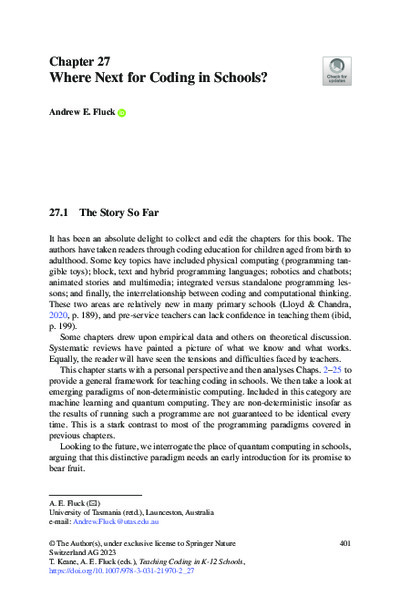Where Next for Coding in Schools?Andrew E. Fluck
Publikationsdatum:
|
 |
 Diese Seite wurde seit 1 Jahr inhaltlich nicht mehr aktualisiert.
Unter Umständen ist sie nicht mehr aktuell.
Diese Seite wurde seit 1 Jahr inhaltlich nicht mehr aktualisiert.
Unter Umständen ist sie nicht mehr aktuell.
 Zusammenfassungen
Zusammenfassungen
 This chapter starts with a personal perspective and then analyses Chaps. 2–25 to provide a general framework for teaching coding in schools. We then take a look at emerging paradigms of non-deterministic computing. Included in this category are machine learning and quantum computing. They are non-deterministic insofar as the results of running such a programme are not guaranteed to be identical every time. This is a stark contrast to most of the programming paradigms covered in previous chapters.
This chapter starts with a personal perspective and then analyses Chaps. 2–25 to provide a general framework for teaching coding in schools. We then take a look at emerging paradigms of non-deterministic computing. Included in this category are machine learning and quantum computing. They are non-deterministic insofar as the results of running such a programme are not guaranteed to be identical every time. This is a stark contrast to most of the programming paradigms covered in previous chapters.Looking to the future, we interrogate the place of quantum computing in schools, arguing that this distinctive paradigm needs an early introduction for ist promise to bear fruit.
 The final chapter of this book summarises the literature on coding in school education and looks to the future. As a mental tool, coding/programming encourages young people to think clearly about concepts, language and agency. Combined with computational thinking skills, they become empowered as active citizens and productive members of an information society. However, this aspect of school education is really only in its infancy and so lacks homogeneity within and between jurisdictions. Schools find it difficult to implement curriculum changes in the computing area fast enough to keep pace with technological developments. For instance, few authors in this book mentioned verbal programming of devices such as Alexa and Siri. Starting from a personal perspective, a general framework for teaching coding is developed. Then a short examination of quantum computing shows where this paradigm can fit into the framework.
The final chapter of this book summarises the literature on coding in school education and looks to the future. As a mental tool, coding/programming encourages young people to think clearly about concepts, language and agency. Combined with computational thinking skills, they become empowered as active citizens and productive members of an information society. However, this aspect of school education is really only in its infancy and so lacks homogeneity within and between jurisdictions. Schools find it difficult to implement curriculum changes in the computing area fast enough to keep pace with technological developments. For instance, few authors in this book mentioned verbal programming of devices such as Alexa and Siri. Starting from a personal perspective, a general framework for teaching coding is developed. Then a short examination of quantum computing shows where this paradigm can fit into the framework. Dieser wissenschaftliche Zeitschriftenartikel erwähnt ...
Dieser wissenschaftliche Zeitschriftenartikel erwähnt ...
 Dieser wissenschaftliche Zeitschriftenartikel erwähnt vermutlich nicht ...
Dieser wissenschaftliche Zeitschriftenartikel erwähnt vermutlich nicht ... 
 Nicht erwähnte Begriffe | Bildung, C (Programmiersprache), Cobol, Informatik, Informatik-Didaktik, LehrerIn, Lehrplan 21, Lernen, Pascal (Programmiersprache), Schweiz, Unterricht |
 Tagcloud
Tagcloud
 Zitationsgraph
Zitationsgraph
 Zitationsgraph (Beta-Test mit vis.js)
Zitationsgraph (Beta-Test mit vis.js)
 Anderswo finden
Anderswo finden
 Volltext dieses Dokuments
Volltext dieses Dokuments
 |  Where Next for Coding in Schools?: Artikel als Volltext @ Springer ( Where Next for Coding in Schools?: Artikel als Volltext @ Springer ( : :  , 513 kByte; , 513 kByte;  : :  ) ) |
 Anderswo suchen
Anderswo suchen 
 Beat und dieser wissenschaftliche Zeitschriftenartikel
Beat und dieser wissenschaftliche Zeitschriftenartikel
Beat hat Dieser wissenschaftliche Zeitschriftenartikel während seiner Zeit am Institut für Medien und Schule (IMS) ins Biblionetz aufgenommen. Beat besitzt kein physisches, aber ein digitales Exemplar. Eine digitale Version ist auf dem Internet verfügbar (s.o.). Es gibt bisher nur wenige Objekte im Biblionetz, die dieses Werk zitieren.









 Digitalisierung
Digitalisierung Gesellschaft
Gesellschaft Informationsgesellschaft
Informationsgesellschaft Künstliche Intelligenz (KI / AI)
Künstliche Intelligenz (KI / AI) machine learning
machine learning Programmieren
Programmieren Schule
Schule Scratch
Scratch turtle graphics
turtle graphics

 Biblionetz-History
Biblionetz-History